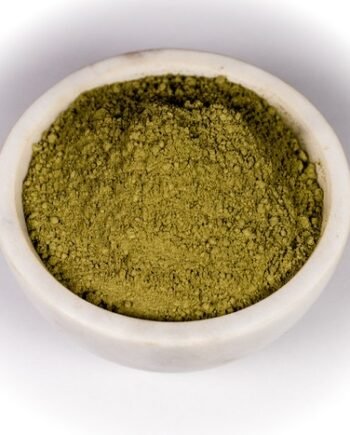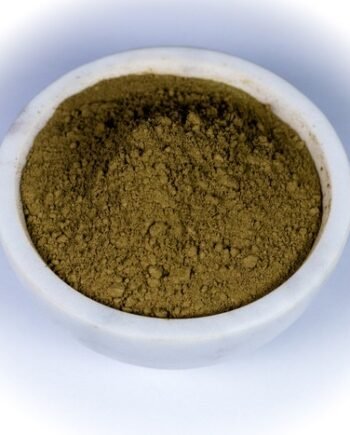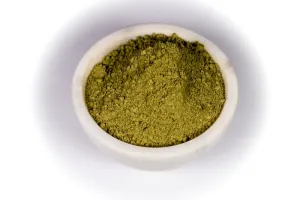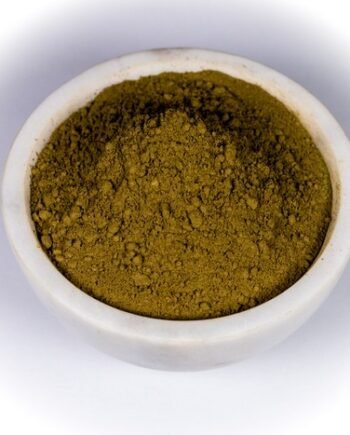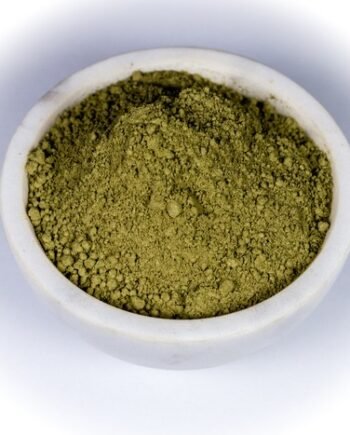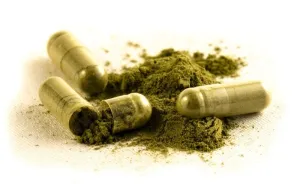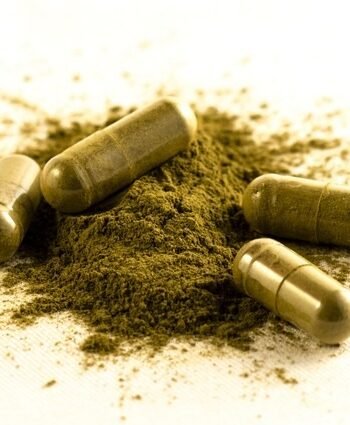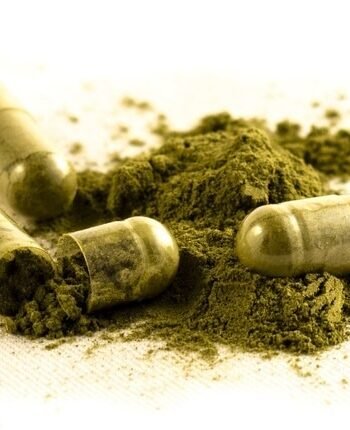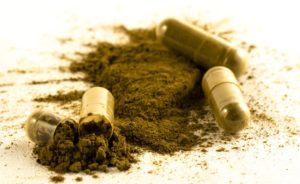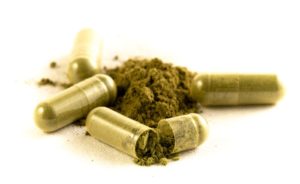Buy Kratom Extract, Powder & Capsules
Our selection of Kratom powder and leaf products. Superior grade natural products are always available with free and same-day shipping.
Buy Kratom Extract Powder Online
Buy Kratom Powder Online
Buy Kratom Capsules Online
What is Kratom?
Before you decide to buy kratom online, it is important to understand what this herb is. Mitragyna Speciosa, or popularly known as Kratom in most parts of the world, is a tree from the Rubiaceae family which was first documented by Pieter Korthals, a Dutch botanist who later named the genus “Mitragyna” due to the similarity to the bishop’s mitre. Mitragyna Speciosa tree is native to the tropical rainforests of Thailand and Indonesia and typically grows to be about 30 feet tall, and 15 feet wide. Mitragyna Speciosa thrives in wet, humus-rich areas, and it requires a mineral rich soil for a healthy tree to grow. It’s dark colored leaves grow to be quite large, with up to 7 inches long and 4 inches wide. The leaves fall or grow depending on the season, and all throughout its flowering stage the florets are completely surrounded and covered by overlapping bracteoles.
Often found in a number of countries in Southeast Asia, specifically in Thailand, Malaysia, and Indonesia, the Mitragyna Speciosa tree grows leaves that are according to research, “abundantly rich in therapeutic and soothing properties,” therefore considered to be one of the most sacred herbs of that region. In Southeast Asia, Mitragyna Speciosa powder and leaves have been used in ceremonies, rituals and folk medicine for centuries and have in only the recent years made its way to the Western World. However, number of countries as well as United States Food and Drug Administration (FDA) strictly prohibit internal use of Mitragyna Speciosa. It is important to note that even though it is legal to buy kratom as well as kratom powder, the internal use of Kratom has not been proven safe, and it is to be completely avoided until United States Food and Drug Administration (FDA), and other governing bodies classify it as safe.
Laws
The native home of Kratom is Thailand, where its use remains illegal to date. However, in many parts of the world, Kratom remains largely contested. Thailand passed laws against the usage of Kratom (Kratom Act 2486) on August 3, 1943. Under the current Thai laws, possession of one ounce of Kratom extract is punishable by death. The law prohibits not only the planting of Kratom trees but also calls for the cutting of existing Kratom trees. The legal status of Kratom has been slightly contested since 2010 when the Thailand’s Narcotic Control Board called for the decriminalization of Kratom asserting that the usage of the plant is part of Thai culture.
Several other countries among them Australia, Burma, Denmark, Finland, Romania, Poland, Malaysia, Vietnam and Lithuania have banned the possession and commercialization of Kratom. Kratom is not controlled in the United States and The Federal Controlled Substances Act does not list the plant and its extracts among the banned substances. Alabama, Arkansas, Indiana, Wisconsin, Vermont, Rhode Island, Tennessee, Sarasota County – FL, San Diego – CA, and Jerseyville – IL have banned the possession, trade and distribution of substances containing Mitragynine and 7-Hydroxymitragynine, and kratom sale and possession are not legal. In United States, U.S. Food and Drug Administration (FDA) strictly prohibits internal use of this herb.
Chemistry
Mitragyna Speciosa leaves have been studied and found to have more than 40 chemical compounds that include a number of alkaloids such as mitragynine, 7-hydroxymitragynine, 7-hydroxymitragynine, and mitragynine pseudoindoxyl to name a few. Other active chemicals run the gamut from Rauwolfia Serpentine (best known as Raubasine) to Yohimbe alkaloids such as corynanthidine.
Kratom leaves have also been found to contain at least on alkaloid, rhynchophylline—a calcium channel block that also reduces NMDA-induced current. The amount of Mitragynine contained in the leaves is dependent on a number of factors, including where the tree was grown. For instance, when harvested from a tree grown in Southeast Asia, the levels tend to be higher when compared to trees grown elsewhere. Greenhouses tend to produce kratom leaves with the lowest amount of Mitragynine. It may even be non-existent. One recent analysis of the leaves, which involved testing them against chromatography-electrospray ionization mass spectrometry (LC-ESI-MS), found the levels of Mitragynine to range between 1 to 6% and 7-hydroxymitragynine at 0.01 to o.04%. Mitragynine has a chemical structure that includes a tryptamine nucleus. This chemical structure is responsible for the molecules observed in adrenergic systems. Some studies even found out that phenolic Methyl ether always tends to be at its strongest in analgesic paradigms.
Mitragynine is very soluble in conventional organic solvents such as acetic acid, acetone, alcohols, diethyl ether, and chloroform, but insoluble in water. It tends to produce a fluorescent solution when dissolved. At five mmHg, Mitragynine will distill at 230 to 240 degrees Celsius, forming a white amorphous crystal that would melt at 102 to 106 degrees Celsius. The melting point of Mitragynine HCL acid is 243 degrees Celsius while picrate would melt 223 or 224 degrees Celsius and acetate at 142 degrees Celsius. Another well-known chemical compound found in the leaves is the 7-hydroxymitragynine. According to a series of recent studies, its potency level is 30-fold higher when compared to that of Mitragynine, which makes it the most active substance in this plant. This puts mitragynine at the second place, even though previous studies always assumed Mitragynine as the main active chemical ingredient found. 7-hydroxymitragynine has also been found to interact with three major opioid sites—Delta, Kappa, and Mu. But preferably, the chemical would bind itself to Mu receptors. The chemical synthesis of several Kratom alkaloids is far too complex to facilitate any form of economic production. Researchers, therefore, prefer to use Mitragynine as a chemical precursor to most of these chemicals.
History
Mentions of Mitragyna Speciosa date back millennia and the information and research concerning it, have spread accurately for hundreds of years. Over the years many botanists and researchers have successfully passed on the true value of this plant; however long term studies on Kratom are still pending quality research. Unlike many other herbs, Kratom doesn’t share a romanticized history and is mostly tied to traditional use as well as folk medicine for peasants and workers who coped with hard labor in Southeast Asia. According to Western literature, first descriptions of Mitragyna Speciosa, now known as Kratom, come from Pieter Willem Korthals, botanists working for the East India Company. Additional literature came from Low, in 1836. He mentioned that the peasants and rural workers of Malaysia distributed it in Malaysia.
First signs of medical research were recorded in 1907 when L. Wray sent samples of both Mitragyna Speciosa and its relatives to the University of Edinburgh where Hooper isolated the alkaloids. This research was rectified in 1921 when Fray named the alkaloids Mitragynine as well as isolating Mitraversine from the leaves of Mitragyna parvifolia. Another medical study came in 1930 from I. H. Burkill, who studied the psychoactive effects and described its traditional use as a medicine, mentioning it as the treatment for diarrhea and fever and use as poultice and ointments. This study was confirmed the Thai study in 1975 by Dr. Sangun Suwanlert, as well as the discovery of three additional alkaloids.
Shortly after the conducted studies, on August 3, 1943, the government of Thailand passed the Kratom Act 2486, declaring the possession and sale of Kratom illegal. According to this law, the remaining trees had to be cut down as well. On January 29, 1993, Ministry of Health declared Mitragyna Speciosa a controlled narcotic drug under Section 30 (b) of the Narcotic Drugs and Psychotropic Substances Law in Myanmar. Followed by the ban in 1993, in 2003, Malaysia illegalized Mitragynine and in 2004 further extended it to the leaves of Mitragyna Speciosa.



